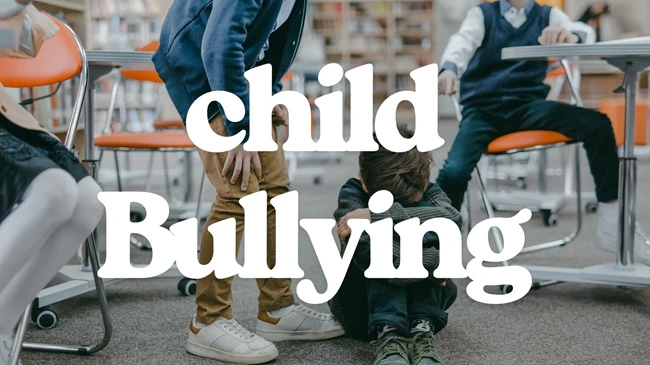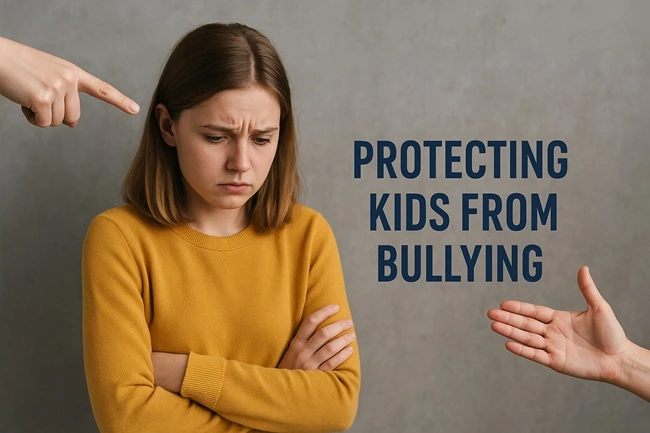As a parent, there’s no bigger nightmare than realizing your child is suffering, especially from something as damaging as bullying. Whether it happens in school, online, or even within a neighborhood, bullying can leave scars that go far beyond the surface. It affects confidence, mental health, and how a child views themselves and the world.
But bullying isn’t just a “phase” or something every child goes through. It’s a serious issue. And as parents, teachers, and responsible members of society, it’s our duty to actively prevent it, recognize it, and fight it with full awareness.
This guide aims to help you understand everything about bullying, from spotting the warning signs and teaching your child how to handle it, to the vital roles schools and parents must play in creating a safe, respectful environment.

What Exactly Is Bullying?
Before anything else, children need to understand what bullying really means. It’s not just teasing or occasional disagreements. Bullying is repeated, intentional, and meant to cause harm either physically, verbally, emotionally or socially.
Some common forms of bullying include:
- Physical – Hitting, kicking, pushing, or damaging belongings
- Verbal – Name calling, insults, threats
- Social/Emotional – Spreading rumors, excluding from groups, public embarrassment
- Cyberbullying – Online harassment, abusive texts, social media shaming
As parents, we must clearly explain these types to our children in a way they understand. Use real life examples (not scary ones, just relatable ones), and make it a two way conversation.
How to Make Children Understand Bullying
Children often don’t know they’re being bullied or that they’re bullying someone else. Here’s how to educate them in a kind and effective way:
1. Talk Regularly and Casually
Keep the conversation light but meaningful. Use TV shows, playground stories, or social media posts as cues to bring it up naturally. Ask questions like:
- “Has anyone in your class been mean lately?”
- “What would you do if someone made fun of your friend?”
2. Define Respect and Boundaries
Teach them to respect others’ feelings and set their own boundaries too. They must know it’s okay to say “no”, and it’s not okay if someone ignores that.
3. Be Honest About Your Experiences
If you faced bullying in your childhood, share those stories. It helps children relate and know they’re not alone.
Teaching Kids Not to Be Bullies
Preventing bullying also means raising children who don’t become bullies themselves. Here’s how:
1. Model Empathy at Home
Kids copy what they see. Speak kindly about others. Avoid gossip or angry outbursts, especially in front of your child.
2. Set Clear Rules on Behavior
Explain that hurting others physically or emotionally is never okay. Praise kindness. Call out aggression.
3. Watch for Early Signs
Sometimes bullying starts with small things bossiness, ignoring others, always wanting control. Correct these behaviors early on.
How to Teach Kids to Raise Their Voice Against Bullying
One of the hardest things for a bullied child is to speak up. They fear retaliation, embarrassment, or not being believed. Here’s how to empower them:
1. Reinforce That Speaking Up Is Brave
Let them know it’s not tattling, it’s protecting themselves and others. Share stories of kids who spoke up and changed things.
2. Create a Safe Sharing Space
Assure them they can talk to you or a teacher without judgment or punishment. Say things like, “Thank you for telling me. You did the right thing.”
3. Encourage Group Support
Bullies often back off when a group resists. Teach your child the power of allyship, standing up together is stronger than standing alone.
What to Do If Your Child Is Being Bullied
If your child confides in you or you suspect bullying, act quickly and calmly:
1. Listen First, React Later
Don’t interrupt or get emotional. Let them share freely. Avoid blaming or pressing for too many details right away.
2. Document Everything
Make note of what happened, when, where, and who was involved. Keep messages, photos, or emails in case it’s cyberbullying.
3. Contact the School
Speak with the class teacher or counselor. Stay polite but firm. Ask about their anti bullying policy and what steps will be taken.
4. Follow Up
Ensure the issue is being addressed. Check in with your child regularly and ask how they’re feeling, not just about school, but about themselves.
A Parent’s Role in Preventing Bullying
As a parent myself, I can tell you, bullying is not always visible. My son once started faking stomach aches just to avoid school. It turned out a classmate was making fun of his accent. I didn’t notice at first, but once he opened up, it hit me hard.
We must become our kids’ safe space:
- Observe behavior changes (sudden silence, skipping meals, avoiding school)
- Stay involved in their social lives
- Teach them that emotions are valid, and asking for help is strength
No app or policy can replace a parent’s consistent presence. Our awareness and action are their best shield.
The Role of Schools and Teachers
A child spends a major part of the day in school. That makes educators the first line of defense when it comes to bullying. Schools must:
- Conduct regular anti bullying workshops
- Have anonymous reporting systems
- Ensure every staff member knows how to handle a bullying case
- Educate children on empathy, diversity, and inclusion
Teachers should watch for signs like isolation, unexplained bruises, or slipping grades. Even if a child doesn’t speak up, their behavior always does.
What Can Society Do?
Bullying is not just a school or family issue, it’s a societal issue. Here’s what communities and society at large must work toward:
- Encourage awareness campaigns in neighborhoods
- Make parks, clubs, and digital spaces safer for children
- Penalize severe bullying under child protection laws
- Support counseling centers for kids and teens
Let’s stop saying “kids will be kids.” That phrase normalizes bullying. Let’s say, “Kids will be kind” and mean it.
How to Deal with Cyberbullying
In today’s digital age, cyberbullying is just as harmful, if not more. Here’s how to keep your child safe:
- Set privacy controls on social media accounts
- Teach them to never respond to online hate
- Encourage them to block and report bullies
- Monitor screen time and behavior afterward
- Keep evidence in case legal action is needed
Also, teach them not to participate in sharing memes or jokes that hurt others online. Every share counts either toward the problem or the solution.
FAQs About Bullying and Children’s Safety
Q. How early should I start teaching my child about bullying?
You can begin by age 3–4 with simple concepts like kindness, sharing, and “use your words, not hands.” By age 6–7, introduce more direct conversations.
Q. Should I confront the bully or their parents directly?
It’s better to go through school authorities or mediators. Direct confrontation can escalate tensions.
Q. Is it okay if my child fights back?
Teach self defense only in extreme cases. The goal should be to walk away, speak up, and seek help not to respond with violence.
Q. What if my child is the bully?
Take it seriously but avoid shaming. Understand the reason behind the behavior. Guide them toward empathy and make consequences clear.
Q. Can therapy help a bullied child?
Absolutely. Therapy or school counseling can rebuild confidence, reduce trauma, and teach coping strategies.
Final Thoughts on How to protect kids from bullying
Bullying isn’t just a childhood issue, it’s a life defining one. What a child experiences during these formative years shapes their self worth, emotional resilience, and future interactions.
As a parent, I’ve learned that the best prevention is presence. Be there. Listen more than you speak. Ask more than you assume. Praise effort, not just results. And always, always remind them that they are loved, valued, and worthy no matter what anyone says.
Let’s raise a generation that knows what bullying is, stands against it, and believes in kindness over cruelty.
Let’s not wait for schools or systems to act let’s act today. For our kids. For every child.
For more Such Parenting Tips Follow Popnewsblend.com.

Hi, I’m Prashant Jain — a curious soul, storyteller, and content creator at heart.I’ve always been drawn to the world of entertainment, travel, sports, health & lifestyle — not just as a writer, but as someone who genuinely lives these experiences. Whether I’m binge-watching the latest OTT series, exploring offbeat spiritual destinations in India, or diving deep into wellness routines and cricket match insights, I love sharing what I discover with like-minded readers.
PopNewsBlend is my way of blending personal journeys with meaningful stories — ones that inform, inspire, and keep you ahead of the curve. Everything I write comes from real observations, hands-on experiences, and a deep passion for understanding the world around us.
Discover more from Popnewsblend
Subscribe to get the latest posts sent to your email.







